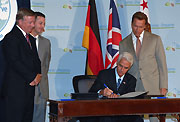 |
||||||||

Florida goes on the Offensive
By Mary Kelley Hoppe
 |
What a difference a year makes. Last year, climate change experts held little sway in Tallahassee, sidelined by what some critics saw as an intransigent administration. Since then, a confluence of events has helped catapult climate change to the forefront of the state’s agenda.
Insurance companies, still reeling from losses caused by the crushing blows of Hurricanes Katrina and Wilma in 2005 and a record four hurricanes in Florida the previous year, have begun pressing for action. Corporate America also is weighing in. In January, the top executives of the nation’s 10 largest companies, including Caterpillar, Alcoa, BP, Duke Energy, General Electric, Lehman Brothers and Pacific Gas & Electric, urged Congress and the Bush Administration to impose mandatory cuts in greenhouse gas emissions, establish a national cap-and-trade system, and invest in alternative energy research.
In February, the Intergovernmental Panel on Climate Change (IPCC) released its Fourth Assessment Report, providing overwhelming evidence that humans are accelerating climate change, noting sharp spikes in greenhouse gases since the industrial era that are unprecedented in more than 10,000 years. By 2100, the IPCC estimates a 2- to 10-degree F increase in average global temperatures and a 7- to 23-inch rise in sea levels.  With more than 1,200 miles of coastline, including more than $1 trillion in waterfront real estate and irreplaceable shoreside habitat, Florida clearly has a lot to lose in a world of rising seas and temperatures.
With more than 1,200 miles of coastline, including more than $1 trillion in waterfront real estate and irreplaceable shoreside habitat, Florida clearly has a lot to lose in a world of rising seas and temperatures.
Florida’s vulnerability has not been lost on the state’s new chief executive. In July, Governor Charlie Crist capped a two-day summit on climate change by mandating reductions in greenhouse gas emissions that are among the most ambitious in the nation. The executive orders aim to reduce greenhouse gas – or GHG – emissions to 2000 levels by 2017, to 1990 levels by 2025, and by 80% of 1990 levels by 2050. Also underway is rulemaking that will require state utilities to produce at least 20% of their electricity from renewable sources, with a strong focus on solar and wind energy. About 2% of Florida’s power comes from renewable sources today.
“We agree that now is the time to start” increasing the use of renewable energies, says Mel Klein, external affairs manager for FP&L in Manatee County, while noting the strides already taken by the utility and community to combat NOx pollution and clean up Tampa Bay.
“We’re on the bridge between fossil fuel technology and new technologies that will replace fossil fuels as we move through this century,” Klein adds.
 |
|
| Gov. Crist and the Sundance Kid Pictured right to left, Florida Gov. Charlie Crist with Robert Redford and Salt Lake City Utah Mayor Rocky Rodriguez at the Mayors Climate Summit at Sundance, Utah in September. |
Leadership by Example
Alongside steep cuts in GHGs, Crist also announced plans to change the way Florida, the state’s largest employer with more than 114,000 employees and 16.8 million square feet of office space, manages its own. Crist has mandated that all state agencies adopt the U.S. Green Building Council’s Leadership in Energy and Environmental Design (LEED®) green building standards for all new buildings, and pursue LEED standards for existing buildings where economically feasible. State agencies also are directed to purchase fuel-efficient vehicles, and maintain existing fleets to reduce fuel consumption.
Environmentalists lauded the governor’s actions and remain cautiously optimistic. “The fact that Governor Crist has directed the utility commission to undertake rulemaking to establish renewable energy standards for Florida goes a long way toward moving the state into a leadership position,” says Steve Smith, executive director of the Southern Alliance for Clean Energy. However, Smith is quick to add that the governor’s resolve will be repeatedly tested as the fast-growing state clamors for more energy.
Finding solutions and weaning the state from its dependence on coal-burning power plants, a chief source of heat-trapping carbon dioxide emissions, won’t be easy or cheap. Thus far, Florida’s investments in solar and wind energy research have been miniscule. Coal remains cheap and plentiful. Natural gas is limited and expensive, and nuclear power plants can take a decade to bring online.
Still, business as usual will be far more costly, argues Smith, who says maximizing energy efficiency is the fastest and most inexpensive method of reducing harmful emissions.
So far, the winds of change appear to be blowing toward clearer skies. This summer, plans for two coal plants were scuttled amid concerns over greenhouse gas emissions. Most recently, in early October, Tampa Electric Company abandoned plans to build a 630-megawatt “clean coal” power plant in Polk County. While emissions from the proposed coal-gasification plant would have been half that of a conventional coal plant, Polk Six still would have emitted about 4.1 million tons of carbon dioxide a year.
Experts have hailed coal-gasification as a promising platform for capturing carbon from coal and storing it deep underground. But the technology is expensive and untested in Florida.
 |
|
| Gov. Crist and California Gov. Arnold Schwarzenegger at the 2007 Florida Summit on Climate Change. |
FP&L Announces World’s Largest Solar Plant
In September, Florida Power & Light Company announced plans to build the world’s largest solar plant in Florida. Plans for the 300-megawatt plant at an undisclosed Florida location, and a 200-megawatt sister facility likely be in the California desert, are part of a $2.4 billion FP&L investment package aimed at increasing U.S. solar energy output and scaling back CO2 emissions.
According to the Florida Solar Energy Center in Cocoa, 300 megawatts is equal to about 1% of the state’s energy output. That’s roughly one-sixth the size of the FP&L-proposed coal plant rejected by the Public Service Commission in August. Company officials stress that the solar plant will not replace the need for conventional power plants.
Solar thermal plants generate electricity by capturing heat from the sun’s rays to boil water into steam, which drives conventional turbine generators.
Company officials say the new facility will offset nearly 11 million tons of CO2 emissions over a 20-year period. As a first step, FP&L expects to construct a 10-megawatt project, then scale up to a 300-megawatt facility after ground-testing the technology and obtaining regulatory approvals.

